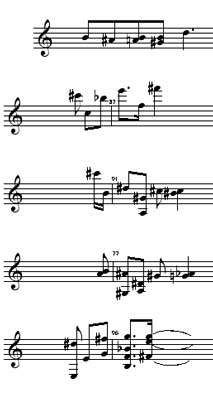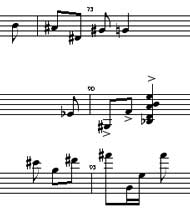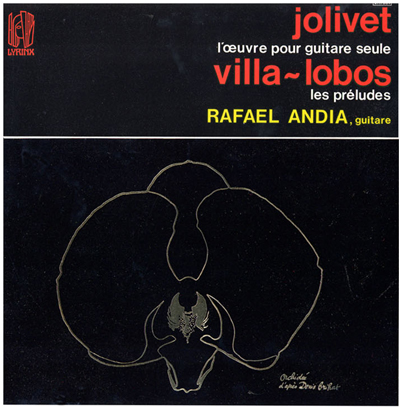The two "Etudes de Concert" for guitar
It is a kind of saraband a little quaint and, one would say, naive in its rhythmic simplicity which is the first theme for Comme un Prélude.., the first of the Deux Etudes. One finds there "the serial use of a widened modal language " characteristic of the last works of Jolivet. The antecedent of the theme sneaks about in G minor, but the tonal impression is destroyed suddenly by the low E pedal; the consequent develops in a very personal mode of 9 sounds (measures 6 to 13): then widening of the melody material on the total chromatic in the commentary (measures 14 to 20). Jolivet could not be confined into such a simple rhythmic form nor use so little varied metres: the median part, softly syncopated, introduces arpeggios of thirty-second notes and a displacement of the strong beats which literally dissolve the rhythmic characters of the beginning (measures 21 to 38). With measure 39 a kind of da capo get us back abruptly to the shade. It is striking to note that in such a classical form (that Jolivet uses as a challenge or a joke!) which is no other than the aria da capo, how the scattering of the metres and the modal or atonal scales, all through the piece, can erase from it an impression of something heard before and completely recreate a new atmosphere in a renewed syntax.
In Comme une Danse it is "the dionysiac explosion of the primitive forces" which seems to blow along this brutal and refined allegro. One immediately recognizes there the "manner" of Jolivet, that of "Pégase" in "Mana" (1935) or of the Ritual Dances, which appears in the extraordinary skill to combine dynamics and agogics. After a vigorous introduction developed on a rhythmic formula of six sounds chords where one has all the brilliance of the flamenco rasgueados, the chains of sixteenths notes sing a small falseta which zigzags in arabesques. At measure 14 a cantabile sentence opens out in the third of the "Modes with limited transpositions " (third transposition) privileged by Messiaen
(1)< style="mso-ansi-language:
FR">

The final is made of a single sentence, one of the longest in our literature (measure 23), developing into a climax, and which combines two melodic and rhythmic cells A and B See some examples of the transformations undergone by B during this development
 A
A  B
B
If "guitaristic working" (what I will call put in tablature) of the text of the first Etude does not offer any difficulty, the same does not apply for the second from there where Jolivet poses to the guitarist more complex problems... It is that, technically speaking, the guitar rather badly adapts to processes familiar of the musical writing (transpositions and distortions sets of themes, combinations of several cells, symmetries various) to which the composers (good ones!) are accustomed to the orchestra or the piano. Just see in our traditional and romantic repertoire the poverty and/or the brevity of the themes and the developments to be convinced.(2)
One could expect it: the Deux Etudes, though published since 1965, were in general carefully avoided by the guitarists, especially the second. "Unplayable": such was a long time the reputation of Comme une Danse(3) . However, more than with strictly digital problems, we deal with problems of a structural or formal complex nature . Intellectual music! The anathema is quickly thrown which provides a hypocritical alibi to the idleness! Nevertheless, if the music of Jolivet is intellectual, it never loses sight of the Human and consequently, as would have said Rousseau, the "beautiful" and the "true". "The games of the spirit are poor when they are free" says us the author himself.
The Suite "Tombeau de Robert de Visée"
It is at the request of Andrès Segovia that Jolivet wrote this Suite paying homage to the favorite guitarist of Louis XIV (himself a guitarist) and whose Suites for the "baroque"guitar are at the top of our literature of the XVIIe century. Did he simply want to perpetuate the old tradition of the Tombeaux to which Visée himself had contributed for Francesco Corbetta, a tradition that lasted until the XXe century with, in particular, the Tombeau de Couperin by Ravel? (We will see further one short allusion to this work). Did he want to echo Benjamin Britten whose Nocturnal for the guitar also wants to be a homage, but this time to his English counterpart to some extent: the lute player John Dowland?
In the kind of conflict which opposes the musical thought of such or such composer and the guitar which must express it, too often our instrument is seen mistreated or at least misused: because of a lack of adequacy, as somebody who would like to get into an undersized piece of clothe. But, as said (or about) Oscar Wilde: the unintelligent man tries to change the milieu, the intelligent man tries to adapt to the milieu.
Here is an example taken among so many others in this Suite, that of the beginning: let us take among the great number of possible scales, the fifth of the "Modes with limited transpositions":

One notices that the root-chord of this mode includes the six sounds of the mode and only intervals of fourths; for these two reasons, it is particularly adapted to the guitar. Jolivet uses a close chord of the same ambiance (with an added note: C) which one would believe, if one were not warned, dictated by the guitar itself, so well it sounds on the instrument:

This interrogative arpeggio is then abundantly taken up again and modified; it will give its conclusion to the Prelude. All the work teeming with musical ideas in perfect symbiosis with the instrument to which they are addressed. One is struck, in the profusion of the modes used in this Suite, by the frequent return of the notes E, G# and C#. These notes will be the "notes•pivots" of the Suite, the E being the fundamental bass [6] .
Also note the role of D # as leading note (Courante measures 10, Passacaille measures 33, 56, 87 etc).(4)
In the Prelude, the rhythmic material is symbolized by the number 5: measure 5/4, frequent quintuplets, which gives to the piece the flexibility and the "vagueness" of the unmeasured Preludes of the Baroque. Let us note the use of "turned over" chromatic formulas which would delight Bartok :

and a beautiful phrase in the second "Mode with limited transpositions" (measures 4 and 5). Also let us note the inverted dynamics compared to what is called the natural phrasing (measures 13, 43, 54).
In the Courante and its Double, Jolivet includes the anacrusis :

and ambiguous measure 6/4 3/2 characteristic of the former Courante Française where hemiolas were required. Even if there is not explicitly the typical bipartite form of the Baroque dances (double median bars with repeats), one can nevertheless easily find the caesura which corresponds to it in measures 10 11 with the notes•pivôts C #, G #, D #, taken here as "dominants". The clarity of the rhythms and the liveliness of the tempi given by Jolivet make these Courantes some of the most difficult pages of all his work for the guitar. But as he said himself: "it pays"! The alternative which appears in the edition for the delicate passage of measure 18 in the Courante is based on modifications which the author had tried to make this passage easier to play or more sounding.
Idem in the Passacaille page 12. In the Saraband, the harmonic atmosphere suddenly changes and rather evokes Falla:

There too, the style is such that fits to the guitar.
Nevertheless the melody material makes one think of the School of Vienna:

Note the odd division of the first sentence: 7 + 5 measures. As in Comme un Prélude, there is dissolution of the rhythms after the first "cadence" (measure 16), then appearance of a splendid phrase punctuated by an obstinato ornament on a high G whose gloomy effect is underlined by the use of low tambora. At the end, a da capo of 7 measures follows a line similar to the first 7 measures. The low Es , abundant in this Saraband, are used as pivot between the Courantes and Passacaille; For the Passacaille Jolivet borrows the same pattern as Visée and his contemporaries and fellow countrymen: refrain and verses, the refrain being defined above all by its harmonic "grid". Let us remember that Britten also finishes his Nocturnal by a Passacaglia but of a very different form: that of the ground or obstinate bass. That allow me to evoke a personal memory on this subject: Jolivet hated this piece!
The first verse, one of the sentences most sublime in all the music written for the guitar, is an amused wink towards the Forlane of the Tombeau de Couperin by Ravel, written for the piano. The parallel between baroque guitar -harpsichord and modern guitar-piano was too tempting for Jolivet not to evoke this other Tombeau thus paying homage to his elder. One also finds there the typical surpointé rhythm of baroque interpretation
.
In the fearsome third couplet, the rhythmic and harmonic fireworks reach such a paroxysm that one is tempted to point out this sentence by Messiaen: "... these swords of fire, these abrupt stars, these orange and blue lava flows , these turquoise planets, these purples, these violets of hairy tree structures, these whirlings of sounds and colours in a tumble of rainbows..." The density of the sound masses, truly orchestral, of a level seldom reached by the guitar, makes one think of the "alchemical" theories of Varese, taken up again by Jolivet, in particular the concept of "transmutation of the sound matter", i.e. the variation of orchestral mass (which is a constant in his work) and also with the concept of the magic of sound: "the music born of the terror of silence was intended to appropriate natural forces and the supernatural ones, i.e. to obtain a magic power".
And also: "the music must be sound initially. And the musician, magus of the universal rhythm officiating music, must initially think sonority "
(5)
However precisely, if the guitar is generally admired as one of the most tempting instruments, it is well thanks to this kind of " magic of the sound" which is characteristic of it and which makes of any (good) guitarist a "researcher of sounds". One immediately sees all that the guitar can bring to these musics, the smoothness of its velvet, the glare of its metal, the canvas of silence and mystery that it can weave around the unutterable and which gives the instrument its irreplaceable magnetism. Undoubtedly, the guitar would not be completely what it is without the works of Jolivet; nevertheless the powerful work of Jolivet would not be fully completed without the small voice of the guitar. "... I like the guitar..." he had claimed. I believe that the guitar pays him back.
R.A.


 A
A  B
B 




